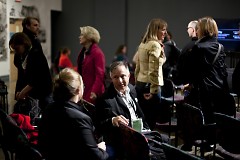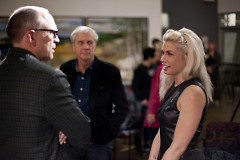
I joined an engaged crowd at the Critical Discourse panelist discussion on Friday night /Eric Tank

The audience, ranging from real estate investors to art students, continued the discussion after the presentation. /Eric Tank
A mix of Grand Rapids art, technology, culture, education and business interests turned out last night to hear panelist Julia Kaganskiy, executive director of the New Museum’s four-week-old art and technology co-working incubator NEW INC, panelist Heather Corcoran, executive director of art and tech blog Rhizome, panelist Adam Harvey, artist/technologist founder of Undisclosed LLC, a privacy and technology design studio and the proprietor of the Privacy Gift Shop and moderator Paul Moore, Communications Director at local business incubator StartGarden, speak from the stage at The Hub, 41 Sheldon SE, on “NEW INC: Incubating Art and Tech,” the fourth installment in the ArtPrize-sponsored Critical Discourse series.
Corcoran and Harvey are two of 40 full-time fee-paying NEW INC members selected from over 400 applicants to have full-time access to the 8,000 square foot co-working space. The space includes amenities typical of both business incubators and maker spaces such as meeting spaces and technical equipment including 3D printers. Aside from access to the space, membership also includes business classes and mentorships.
“We did an assessment of other programs and most are at most a week-long seminar or work shop,” Kaganskiy noted. She went on to explain that the values people bring to NEW INC are different than values at a conventional business incubator because “they are not necessarily devoted to profit, scale or attracting investors.”
All three panelists spoke with great enthusiasm and excitement in support of NEW INC’s goal to support and diversify creative industries in New York City. A study by the New York Center for an Urban Future indicates that although New York turns out many art and design graduates who would like to stay in the city, unfortunately most don’t have resources to do so. Another study conducted by software company Intuit indicates that by 2020, more than 40 percent of the American workforce, or 60 million people, will be freelancers, contractors and temp workers. When NEW INC members leave after a maximum two-year stint, Kaganskiy hopes that they will be able to set up independent shops in the City. She envisions NEW INC alumni becoming part of a vibrant New York City cultural and economic ecosystem as co-creators of a community that is greater than the sum of its parts.
Kaganskiy and Corcoran described many intriguing examples of solo practitioners, creative studios, product builders and hybrids. Rafaël Rozendaal is an artist who creates unique URLs and websites in order to sell them to people who agree to be stewards, artist Lisa Park uses technology to detect her brain activity and then displays it in real-time as waves on pools of water and Carlo Van de Roer has created novel techniques for manipulating light in images and is working on patenting his inventions. NEW INC tries to help its members leverage the intellectual property they are creating without taking a financial interest.
Kaganskiy described Corcoran’s Rhizome as an "anchor tenant" whose prestige and name recognition attracts others. When asked what motivated Rhizome to be a NEW INC Anchor Tenant, Corcoran replied that the Rhizome, an organization affiliated with the New Museum for the past 11 years, was attracted by the mission of NEW INC, not to mention having a nicer space with windows. According to Corcoran, Rhizome benefits by sharing co-working space that intentionally supports “art in conversation with contemporary culture.”
Harvey is an individual artist who has developed several “counter-surveillance” conceptual art products that he’s been selling online via his Privacy Gift Shop and at physical locations instead of through traditional art galleries. His best seller is his Off Pocket signal blocking cell phone case that has sold 800 units at $80 each since its start as a Kickstarter campaign in August 2013. The Off Pocket caught the attention of the New York Times, TechCrunch, 60 Minutes and various government agencies.
“The gallery model was a barrier for me, and this gift shop model is better," he says. “When people describe themselves as an artist, they get less money for a job than when they describe themselves as technologists or engineers.”
The three panelists seem united by an intrepid desire to confront semantic issues and traditional boundaries in art, technology, business and society.
Rick DeVos, founder of Grand Rapids’ business incubator Start Garden, asked Kaganskiy what crazy dreams NEW INC might have for the future.
“[I'm excited] to leverage the interdisciplinary community we’ve assembled for social impact,” she says. “I'd love to think how we can galvanize and leverage the community around a civic issue.”
Stan Samuels, Interim Executive Director of Grand Rapids’ business incubator, GR Current, seems excited by artists who are starting their own tech-oriented businesses or adding a “missing ingredient” to entrepreneur teams.
Sam Cummings, who represented the evening’s sponsor CWD Real Estate, applauded the panelists.
“In my experience, the best businesses and creation of business is motivated by the pursuit of the idea – pursuit of the disruption – not the money," says Cummings. "Usually the sustainability is due to the founder finding a way to turn a small failure into another disruption.”
The Rapidian, a program of the 501(c)3 nonprofit Community Media Center, relies on the community’s support to help cover the cost of training reporters and publishing content.
We need your help.
If each of our readers and content creators who values this community platform help support its creation and maintenance, The Rapidian can continue to educate and facilitate a conversation around issues for years to come.
Please support The Rapidian and make a contribution today.